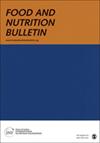Sensory Trial of Quintuple Fortified Salt—Salt Fortified With Iodine, Iron, Folic Acid, Vitamin B12, and Zinc—Among Consumers in New Delhi, India
IF 1.8
4区 医学
Q3 FOOD SCIENCE & TECHNOLOGY
引用次数: 2
Abstract
Background: Micronutrient deficiencies are a cause of significant public health burden and loss of gross domestic product, especially in developing countries. Multiple fortified salt can potentially address this challenge at scale and in a cost-effective manner. Objective: This laboratory-based sensory trial evaluated the acceptability of quintuple fortified salt (Q5FS), that is, iodized salt (IS) fortified with additional 4 micronutrients: iron, folic acid, vitamin B12, and zinc. Iodized salt and double fortified salt (DFS), that is, IS fortified with iron, are used for comparison. Methods: Forty-five respondents were recruited by open invitations to the university staff and their families. Each study participant rated 10 food items each in a set of 3 identical preparations differing only in the salt used. A 5-point hedonic scale was used to rate each dish on 6 sensory attributes: appearance, color, aroma, taste, texture, and aftertaste. Finally, the dish was rated on the attribute of overall acceptability—a subjective combined score based on all sensory attributes considered together. Results: Among the 3 salt types, there was no difference in scores for the sensory attributes of appearance, aroma, taste, texture, and aftertaste, and the attribute of overall acceptability. Color in IS scored significantly higher than in Q5FS and DFS, but there was no difference between the scores of DFS and Q5FS. Conclusions: The 3 salts IS, DFS, and Q5FS are comparable to each other in all sensory properties, except for color. This study concludes that Q5FS is organoleptically acceptable under ideal conditions.五倍强化盐的感官试验——加碘、铁、叶酸、维生素B12和锌的盐——在印度新德里的消费者中
背景:微量营养素缺乏是造成重大公共卫生负担和国内生产总值损失的一个原因,特别是在发展中国家。多重强化盐有可能以具有成本效益的方式大规模解决这一挑战。目的:本以实验室为基础的感官试验评估了五倍强化盐(Q5FS)的可接受性,即碘化盐(is)添加了额外的4种微量营养素:铁、叶酸、维生素B12和锌。碘盐和双强化盐(DFS),即铁强化盐,用于比较。方法:采用公开邀请的方式,对45名高校工作人员及其家属进行问卷调查。每个研究参与者对10种食物进行评分,每一种食物都是三种相同的制剂,不同的只是所用的盐。一个5分制的享乐量表用于对每道菜的6个感官属性进行评分:外观、颜色、香气、味道、质地和回味。最后,对菜肴的整体可接受度进行评分,这是一种基于所有感官属性的主观综合评分。结果:3种盐的外观、香气、口感、质地、余味感官属性和总体可接受性属性得分均无差异。IS的颜色得分明显高于Q5FS和DFS,而DFS和Q5FS的得分无差异。结论:IS、DFS、Q5FS三种盐在除颜色外的所有感官特性上均具有可比性。本研究认为,在理想条件下,Q5FS在感官上是可接受的。
本文章由计算机程序翻译,如有差异,请以英文原文为准。
求助全文
约1分钟内获得全文
求助全文
来源期刊

Food and Nutrition Bulletin
工程技术-食品科技
CiteScore
4.10
自引率
0.00%
发文量
31
审稿时长
18-36 weeks
期刊介绍:
The Food and Nutrition Bulletin (FNB,) is a peer-reviewed, academic journal published quarterly by the Nevin Scrimshaw International Nutrition Foundation. The Journal is one of the leading resources used by researchers, academics, nutrition policy makers and planners in over 125 countries to obtain the most current research and policy information related to nutrition in developing countries.
 求助内容:
求助内容: 应助结果提醒方式:
应助结果提醒方式:


